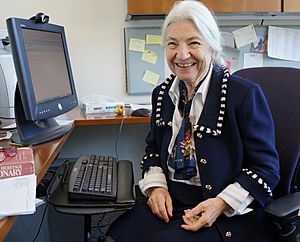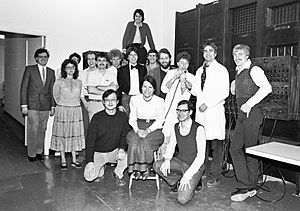Ruzena Bajcsy facts for kids
Quick facts for kids
Ruzena Bajcsy
|
|
|---|---|

Bajcsy in 2013
|
|
| Born |
Ružena Kučerová
May 28, 1933 Bratislava, Czechoslovakia
|
| Citizenship | United States |
| Alma mater | Slovak Technical University; Stanford |
| Known for | Artificial intelligence; Computer Vision; Robotics; Sensor Networks; Control; Biosystems; General Robotics and Active Sensory Perception Laboratory |
| Awards | Benjamin Franklin Medal (2009) ACM Distinguished Service Award (2003) Computing Research Association Distinguished Service Award (2003) ACM/AAAI Allen Newell Award (2001) IEEE Robotics and Automation Award (2013) John Scott Medal (2017) Order of the White Double Cross, 2nd class (2022) |
| Scientific career | |
| Fields | Electrical Engineering and Computer Science |
| Institutions | University of California, Berkeley; University of Pennsylvania |
| Doctoral advisor | John McCarthy |
| Doctoral students |
|
Ruzena Bajcsy (born May 28, 1933) is an American engineer and computer scientist. She is famous for her work in robotics. She is a professor of electrical engineering and computer sciences at the University of California, Berkeley. There, she was also the director emerita of CITRIS.
Before this, she was a professor and chair of computer science and engineering at the University of Pennsylvania. She started the General Robotics and Active Sensory Perception (GRASP) Laboratory there. She also led the National Science Foundation's Computer and Information Science and Engineering Directorate. She helped many students earn their doctoral degrees.
Contents
Early Life and Inspiration

Ruzena Bajcsy was born on May 28, 1933, in Bratislava, Czechoslovakia. This country is now known as Slovakia. Her family faced many challenges during World War II. Most of her adult relatives were killed by the Nazis. Ruzena and her sister were the only ones who survived. The Red Cross helped them as war orphans. Ruzena grew up in orphanages and foster care.
These tough experiences made her very strong and determined. Living under Communist rule in Czechoslovakia also brought difficulties. It was hard to get a good education or job if you didn't agree with the government. Ruzena was excellent at math. She loved its logic and how it helped solve problems. However, she chose to study electrical engineering. This was because a math career often meant teaching, which required supporting ideas she didn't believe in.
Despite these challenges, Ruzena did very well in her studies. She overcame gender biases in science and engineering fields. She became very interested in how machines could "see" and understand their surroundings. This was a big problem for robotics and medical imaging. Early computer vision systems were not very good. They just looked at images without interacting. Ruzena realized that humans actively explore their environment to understand it. She wanted machines to do the same. This idea is called "active perception." It means machines can move and adjust their sensors to understand things better.
Education and Achievements
Ruzena Bajcsy earned her Master's and Ph.D. degrees in electrical engineering. She got them from Slovak Technical University in 1957 and 1967. She then earned another Ph.D. in computer science in 1972 from Stanford University. Her Ph.D. paper was about how computers could identify textured scenes. Her advisor was John McCarthy.
She has received many special honors. In 2001, she got an honorary doctorate from the University of Ljubljana in Slovenia. From 2003 to 2005, she was part of the President's Information Technology Advisory Committee. In November 2002, Discover magazine named her one of the 50 most important women in science. She also received honorary doctorates from the University of Pennsylvania and KTH in Sweden in 2012.
Amazing Innovations
Ruzena Bajcsy's research has greatly changed how robots perceive and control themselves. In 1978, she started the General Robotics, Automation, Sensing, and Perception (GRASP) Lab. This was at the University of Pennsylvania. Under her leadership, the GRASP Lab became a top center for robotics research. It brought together engineers, computer scientists, and brain scientists.
One of her most important ideas is "active perception." This means a robot's movements are key to how it gathers and understands information. This was a new way of thinking. It made robotic systems much more efficient and adaptable. Her work in this area is a foundation for advances in computer vision and artificial intelligence.
Ruzena Bajcsy also made big contributions to medical imaging. She developed "elastic matching algorithms." These algorithms help align different medical images. This makes diagnoses more accurate and helps doctors plan treatments better.
Impact and Lasting Legacy
Ruzena Bajcsy's inventions have had a huge impact on both universities and industries. The ideas of active perception are now used in many robotic systems. This helps them interact with and adapt to changing environments. Her work in medical imaging has made diagnostic tools more precise. This helps patients get better care.
Beyond her research, Ruzena Bajcsy has been a pioneer for women in engineering and computer science. She was one of the few women in her field when she started. She has always supported diversity and inclusion in science and technology. Her guidance has inspired many students, especially women, to pursue careers in these fields.
Current Research and Relevance
Ruzena Bajcsy's ideas are still very important today. The concept of active perception continues to shape how autonomous systems are designed. This includes things like self-driving cars and drones. Her work in medical imaging is still used in modern diagnostic techniques. Also, the way she set up the GRASP Lab encourages teamwork in robotics and AI research worldwide.
Her current research focuses on several exciting areas:
- Artificial intelligence
- Biosystems and computational biology
- Control, intelligent systems, and robotics
- Graphics and human-computer interaction
- Computer vision
- Security
Memberships and Awards
Ruzena Bajcsy is a member of important groups like the National Academy of Engineering and the National Academy of Sciences. She is also a Fellow of the Association for Computing Machinery (ACM), the Institute of Electrical and Electronics Engineers, and the American Association for Artificial Intelligence.
She has received many awards for her amazing work:
- In 2001, she received the Association for Computing Machinery (ACM)/Association for the Advancement of Artificial Intelligence Allen Newell Award.
- In 2003, she received the ACM Distinguished Service Award and the Computing Research Association Distinguished Service Award.
- In 2009, she received the Benjamin Franklin Medal in Computer and Cognitive Science. This was for her work in robotics and computer vision. She helped create better ways for robots to perceive and analyze medical images.
- Also in 2009, she won the ABIE Award for Technical Leadership from the Anita Borg Institute.
- In 2013, the IEEE Board of Directors gave her the IEEE Robotics and Automation Award. This was for her contributions to computer vision, active perception, and medical robotics.
- She is featured in the Notable Women in Computing cards.
- In 2022, she received the Order of the White Double Cross, Second Class, from the president of Slovakia, Zuzana Čaputová. This award was for spreading the good name of the Slovak Republic abroad.
See also
 In Spanish: Ružena Bajcsy para niños
In Spanish: Ružena Bajcsy para niños

